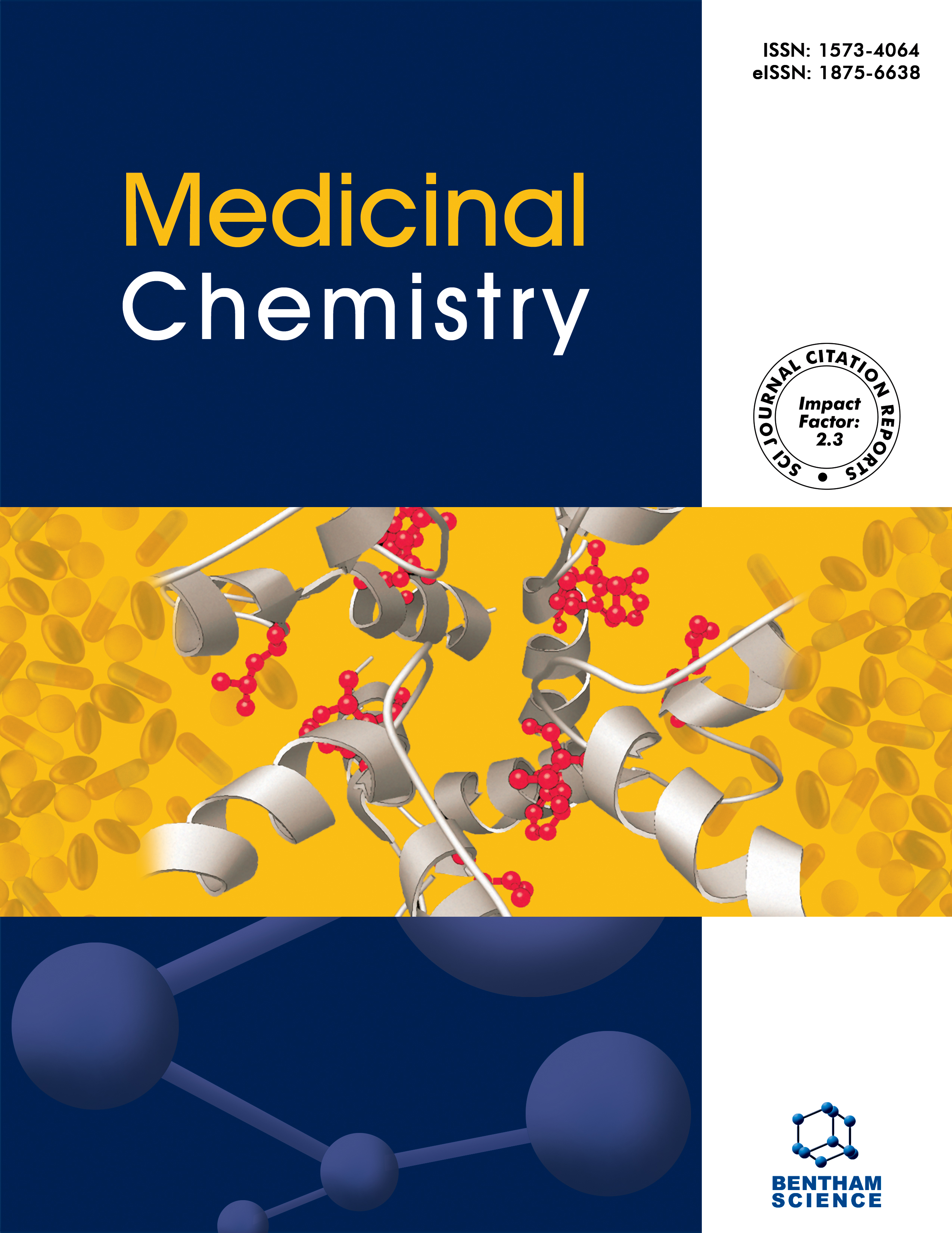- Home
- A-Z Publications
- Medicinal Chemistry
- Previous Issues
- Volume 13, Issue 2, 2017
Medicinal Chemistry - Volume 13, Issue 2, 2017
Volume 13, Issue 2, 2017
-
-
Cystic Fibrosis Revisited – a Review Study
More LessAuthors: Blanka Klimova, Kamil Kuca, Michal Novotny and Petra MaresovaBackground: Cystic fibrosis (CF) is an incurable, chronic disease, which causes severe damages to respiratory and digestive tracts. It is the most common genetically inherited disease among caucasians. This disease is caused by defects in CF genes, the so-called mutations in cystic fibrosis transmembrane conductance regulator (CFTR) gene population. At present over 100,000 people suffer from this disease worldwide. Obj Read More
-
-
-
Thio- and Semicarbazones: Hope in the Search for Treatment of Leishmaniasis and Chagas Disease
More LessAuthors: Barbara V. Silva and Bianca N.M. SilvaBackground: Trypanosomiasis and leishmaniasis cause severe infections in humans and domestic animals in the tropics. Although typical diseases in Latin America, globalization and the migration of infected people has spread these diseases to countries in North America, Asia and Europe. Currently available drugs are not effective in the chronic phase, as well as cause side effects and develop resistance. Results: Among the Read More
-
-
-
Differences in Antiproliferative Activity Between Salinomycin-AZT Conjugates Obtained via ‘Click’ and Esterification Reactions
More LessAuthors: Michal Antoszczak, Ewa Maj, Natalia Kleczewska, Joanna Wietrzyk, Lech Celewicz and Adam HuczynskiBackground: Pharmacophore hybridization by bioconjugation, in which two bioactive moieties are covalently linked, is one of the current strategies in drug discovery for the development of new compounds with improved affinity and efficacy relative to those of the parent molecules. Prompted by the idea that cancer cells may be effectively killed by 3'-azido-3'-deoxythymidine (AZT) and salinomycin (SAL) individually, we synthes Read More
-
-
-
Synthesis, Screening and in silico Simulations of Anti-Parasitic Propamidine/Benzimidazole Derivatives
More LessBackground: We designed hybrid molecules between propamidine and benzimidazole in order to retain the antiprotozoal action, but decreasing the toxic effect of the molecule. Objective: Design and prepare 12 hybrids for testing their antiparasitic effect over three protozoa: Giardia intestinalis, Trichomonas vaginalis and Leishmania mexicana, as well as conduct several in silico simulations such as toxicological profile, molecular Read More
-
-
-
Synthesis, Biological Evaluation and Molecular Docking of New Benzenesulfonylhydrazone as Potential anti-Trypanosoma cruzi Agents
More LessBackground: Chagas disease is a public health problem caused by Trypanosoma cruzi. Cruzain is a pharmacological target for designing a new drug against this parasite. Hydrazone and Nacylhydrazone derivatives have been traditionally associated as potential Cruzain inhibitors. Additionally, benzenesulfonyl derivatives show trypanocidal activity. Therefore, in this study, the combination of both structures has been taken into a Read More
-
-
-
Synthesis and Immunosuppressive Activity of New Mycophenolic Acid Derivatives
More LessBackground: Immunosuppressive drugs are widely used to prevent and treat allograft rejection and autoimmune diseases. Mycophenolic acid (MPA) and its derivatives are currently one of the most prescribed immunosuppressive drugs; however, metabolic drawbacks and variable interand intrapatient responses limit their use. Objective: In order to find out new safe and effective immunosuppressive compounds, we report h Read More
-
-
-
Benzoflavonoids Structure Hinders Human Colon Cancer Clonogenicity
More LessAuthors: Yeonjoong Yong, Eun J. Koh, Seunghyun Ahn, Beom S. Kim, Young H. Lee, Soon Y. Shin and Yoongho LimBackground: Since flavonoids fused by benzene have been known for their potent chemopreventive effects, in this study, we examined the relationship between the structures and activities of benzoflavones, benzoflavanones, benzochalcones, and benzochalcone derivatives bearing the pyrazole moiety against human colon cancer cells. Methods: We investigated the effect of 34 benzoflavonoids on the inhibition of colon c Read More
-
-
-
Synthesis, Biological Evaluation and Docking Studies of Sorafenib Derivatives N-(3-fluoro-4-(pyridin-4-yloxy)phenyl)-4(5)-phenylpicolinamides
More LessAuthors: Min Wang, Chunjiang Wu, Shan Xu, Yan Zhu, Wei Li, Pengwu Zheng and Wufu ZhuBackground: Sorafenib is an important VEGFR2/KDR inhibitor which is widely used for the treatment of cancer. Objective: In this paper, two series of sorafenib analogues N-(3-fluoro-4-(pyridin-4-yloxy)phenyl)-4- phenylpicolinamides(13a–k) and N-(3-fluoro-4-(pyridin-4-yloxy)phenyl)-5-phenylpicolinamides (14a–k) were designed and synthesized. Methods: Their structures were confirmed by various analytical methods, s Read More
-
-
-
Docking Studies, Synthesis and Biological Evaluation of β-aryl-β-hydroxy Propanoic Acids for Anti-inflammatory Activity
More LessBackground: Nonsteriodal anti-inflammatory drugs (NSAIDs) are numerous and widely used for more than 60 years, but there is still a strong need for developing novel selective NSAIDs. The need is justified by the fact that nonselective NSAIDs can produce serious gastric side effects and that some of the selective NSAID are withdrawn due to their cardiotoxic side effects. Methods: Eight β-hydroxy-β-arylpropanoic acids, which Read More
-
-
-
Synthesis, Characterization and Biological Activities of Creatinine Amides and Creatinine Schiff Bases
More LessBackground: In spite of substantial progress in scientific cognizance and medical technology, still infectious diseases are among the leading cause of morbidity and mortality. Creatinine and Schiff bases are well known for their diverse range of biological activities and thought to be emerging and useful therapeutic target for the treatment of several diseases. Methods: The present work was aimed to illustrate the influence of s Read More
-
Volumes & issues
-
Volume 21 (2025)
-
Volume 20 (2024)
-
Volume 19 (2023)
-
Volume 18 (2022)
-
Volume 17 (2021)
-
Volume 16 (2020)
-
Volume 15 (2019)
-
Volume 14 (2018)
-
Volume 13 (2017)
-
Volume 12 (2016)
-
Volume 11 (2015)
-
Volume 10 (2014)
-
Volume 9 (2013)
-
Volume 8 (2012)
-
Volume 7 (2011)
-
Volume 6 (2010)
-
Volume 5 (2009)
-
Volume 4 (2008)
-
Volume 3 (2007)
-
Volume 2 (2006)
-
Volume 1 (2005)
Most Read This Month
Article
content/journals/mc
Journal
10
5
false
en


